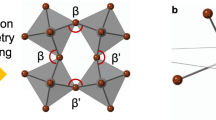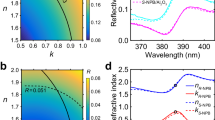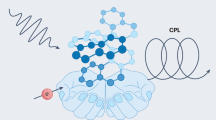Abstract
In hybrid metal halide perovskites, chiroptical properties typically arise from structural symmetry breaking by incorporating a chiral A-site organic cation within the structure, which may limit the compositional space. Here we demonstrate highly efficient remote chirality transfer where chirality is imposed on an otherwise achiral hybrid metal halide semiconductor by a proximal chiral molecule that is not interspersed as part of the structure yet leads to large circular dichroism dissymmetry factors (gCD) of up to 10−2. Density functional theory calculations reveal that the transfer of stereochemical information from the chiral proximal molecule to the inorganic framework is mediated by selective interaction with divalent metal cations. Anchoring of the chiral molecule induces a centro-asymmetric distortion, which is discernible up to four inorganic layers into the metal halide lattice. This concept is broadly applicable to low-dimensional hybrid metal halides with various dimensionalities (1D and 2D) allowing independent control of the composition and degree of chirality.

This is a preview of subscription content, access via your institution
Access options
Access Nature and 54 other Nature Portfolio journals
Get Nature+, our best-value online-access subscription
$32.99 / 30 days
cancel any time
Subscribe to this journal
Receive 12 print issues and online access
$259.00 per year
only $21.58 per issue
Buy this article
- Purchase on SpringerLink
- Instant access to full article PDF
Prices may be subject to local taxes which are calculated during checkout




Similar content being viewed by others
Data availability
All data are available in the Article and Supplementary Information, or on request from the corresponding authors. Supplementary Data 1 contains the structure coordinates for lattice and relaxed ion positions. Source data are provided with this paper.
References
Zhang, L., Zhang, X. & Lu, G. Intramolecular band alignment and spin–orbit coupling in two-dimensional halide perovskites. J. Phys. Chem. Lett. 11, 6982–6989 (2020).
Crassous, J. et al. Materials for chiral light control. Nat. Rev. Mater. 8, 365–371 (2023).
Bloom, B. P., Paltiel, Y., Naaman, R. & Waldeck, D. H. Chiral induced spin selectivity. Chem. Rev. 124, 1950–1991 (2024).
Mathew, S. P., Mondal, P. C., Moshe, H., Mastai, Y. & Naaman, R. Non-magnetic organic/inorganic spin injector at room temperature. Appl. Phys. Lett. 105, 242408 (2014).
Kim, Y.-H. et al. Chiral-induced spin selectivity enables a room-temperature spin light-emitting diode. Science 371, 1129–1133 (2021).
Chen, C. et al. Circularly polarized light detection using chiral hybrid perovskite. Nat. Commun. 10, 1927 (2019).
Kim, K. et al. Chiral-phonon-activated spin Seebeck effect. Nat. Mater. 22, 322–328 (2023).
Lu, H. et al. Highly distorted chiral two-dimensional tin iodide perovskites for spin polarized charge transport. J. Am. Chem. Soc. 142, 13030–13040 (2020).
Jana, M. K. et al. Structural descriptor for enhanced spin-splitting in 2D hybrid perovskites. Nat. Commun. 12, 4982 (2021).
Jana, M. K. et al. Organic-to-inorganic structural chirality transfer in a 2D hybrid perovskite and impact on Rashba–Dresselhaus spin–orbit coupling. Nat. Commun. 11, 4699 (2020).
Lu, H., Vardeny, Z. V. & Beard, M. C. Control of light, spin and charge with chiral metal halide semiconductors. Nat. Rev. Chem. 6, 470–485 (2022).
Long, G. et al. Chiral-perovskite optoelectronics. Nat. Rev. Mater. 5, 423–439 (2020).
Kim, Y.-H. et al. Strategies to achieve high circularly polarized luminescence from colloidal organic–inorganic hybrid perovskite nanocrystals. ACS Nano 14, 8816–8825 (2020).
Tran, T. K. T. et al. Anionic ligand-induced chirality in perovskite nanoplatelets. Chem. Commun. 59, 1485–1488 (2023).
Long, G. et al. Perovskite metasurfaces with large superstructural chirality. Nat. Commun. 13, 1551 (2022).
Kim, H. et al. Ultrasensitive near-infrared circularly polarized light detection using 3D perovskite embedded with chiral plasmonic nanoparticles. Adv. Sci. 9, e2104598 (2022).
Chen, G. et al. Nucleation-mediated growth of chiral 3D organic-inorganic perovskite single crystals. Nat. Chem. 15, 1581–1590 (2023).
Kim, Y. H. et al. The structural origin of chiroptical properties in perovskite nanocrystals with chiral organic ligands. Adv. Funct. Mater. 32, 2200454 (2022).
Zhong, D. et al. Layer-resolved magnetic proximity effect in van der Waals heterostructures. Nat. Nanotechnol. 15, 187–191 (2020).
Reid, J. P. Open questions on the transfer of chirality. Commun. Chem. 4, 171 (2021).
Clayden, J., Lund, A., Vallverdú, L. & Helliwell, M. Ultra-remote stereocontrol by conformational communication of information along a carbon chain. Nature 431, 966–971, (2004).
Zhang, Y., Wang, Y. & Dai, W.-M. Efficient remote axial-to-central chirality transfer in enantioselective smi2-mediated reductive coupling of aldehydes with crotonates of atropisomeric 1-naphthamides. J. Org. Chem. 71, 2445–2455, (2006).
Ikai, T. et al. Control of one-handed helicity in polyacetylenes: impact of an extremely small amount of chiral substituents. J. Am. Chem. Soc. 145, 24862–24876 (2023).
Yashima, E. et al. Supramolecular helical systems: helical assemblies of small molecules, foldamers, and polymers with chiral amplification and their functions. Chem. Rev. 116, 13752–13990 (2016).
Wang, Y. et al. Elucidation of the origin of chiral amplification in discrete molecular polyhedra. Nat. Commun. 9, 488 (2018).
Green, M. M. et al. Macromolecular stereochemistry: the out-of-proportion influence of optically active comonomers on the conformational characteristics of polyisocyanates. The sergeants and soldiers experiment. J. Am. Chem. Soc. 111, 6452–6454 (1989).
Wang, Y. B. & Tan, B. Construction of axially chiral compounds via asymmetric organocatalysis. Acc. Chem. Res. 51, 534–547 (2018).
Qin, T. et al. Atropselective syntheses of (−) and (+) rugulotrosin A utilizing point-to-axial chirality transfer. Nat. Chem. 7, 234–240 (2015).
Mahal, E., Mandal, S. C. & Pathak, B. Understanding the role of spacer cation in 2D layered halide perovskites to achieve stable perovskite solar cells. Mater. Adv. 3, 2464–2474 (2022).
Pham, M. T. et al. Strong Rashba–Dresselhaus effect in nonchiral 2D Ruddlesden–Popper perovskites. Adv. Optical Mater. 10, 2101232 (2021).
Sercel, P. C., Vardeny, Z. V. & Efros, A. L. Circular dichroism in non-chiral metal halide perovskites. Nanoscale 12, 18067–18078 (2020).
Lin, C. W. et al. Structure-dependent photoluminescence in low-dimensional ethylammonium, propylammonium, and butylammonium lead iodide perovskites. ACS Appl. Mater. Interfaces 12, 5008–5016 (2020).
Luo, B. et al. Efficient trap-mediated Mn2+ dopant emission in two dimensional single-layered perovskite (CH3CH2NH3)2PbBr4. J. Phys. Chem. C 123, 14239–14245 (2019).
Mao, L. et al. Tunable white-light emission in single-cation-templated three-layered 2D perovskites (CH3CH2NH3)4Pb3Br10−xClx. J. Am. Chem. Soc. 139, 11956–11963 (2017).
Ogunniran, K. O., Murugadoss, G., Thangamuthu, R., Karthikeyan, J. & Murugan, P. Integration of phenylammoniumiodide (PAI) as a surface coating molecule towards ambient stable MAPbI3 perovskite for solar cell application. Sol. Energy Mater. Sol. Cells 191, 316–328 (2019).
Ghoreishi, F. S. et al. Enhanced performance of CH3NH3PbI3 perovskite solar cells via interface modification using phenyl ammonium iodide derivatives. J. Power Sources 473, 228492 (2020).
Kim, S. Y., Yang, J. M., Choi, E. S. & Park, N. G. Effect of interlayer spacing in layered perovskites on resistive switching memory. Nanoscale 11, 14330–14338 (2019).
Jokar, E. et al. Enhanced performance and stability of 3D/2D tin perovskite solar cells fabricated with a sequential solution deposition. ACS Energy Lett. 6, 485–492 (2021).
Quan, L. N. et al. Vibrational relaxation dynamics in layered perovskite quantum wells. Proc. Natl Acad. Sci. USA 118, e2104425118 (2021).
Li, Z. et al. A new organic interlayer spacer for stable and efficient 2D Ruddlesden–Popper perovskite solar cells. Nano Lett. 19, 5237–5245 (2019).
Lu, H. et al. Spin-dependent charge transport through 2D chiral hybrid lead-iodide perovskites. Sci. Adv. 5, eaay0571 (2019).
Long, G. et al. Spin control in reduced-dimensional chiral perovskites. Nat. Photonics 12, 528–533 (2018).
Fortino, M., Mattoni, A. & Pietropaolo, A. Atomistic modeling of metal–ligand chirality transfer and chiroptical properties of lead and tin hybrid perovskites. J. Mater. Chem. C 11, 9135–9143 (2023).
Xie, Y. et al. Chiral cation doping for modulating structural symmetry of 2D perovskites. J. Am. Chem. Soc. 145, 17831–17844 (2023).
Wu, Y. et al. Ligand-assisted self-assembly of 3D perovskite nanocrystals into chiral inorganic quasi-2D perovskites (n = 3) with ligand-ratio-dependent chirality inversion. Small 19, e2301034 (2023).
Wan, L. et al. Inverting the handedness of circularly polarized luminescence from light-emitting polymers using film thickness. ACS Nano 13, 8099–8105 (2019).
Jiang, X. et al. Top-down induced crystallization orientation toward highly efficient p–i–n perovskite solar cells. Adv. Mater. 36, 2313524 (2024).
Su, Y., Xu, C., Gao, L., Wei, G. & Ma, T. Solvent-assisted crystallization of two-dimensional Ruddlesden–Popper perovskite. Chem. Commun. 57, 10552–10555 (2021).
Nam, J. K. et al. Potassium incorporation for enhanced performance and stability of fully inorganic cesium lead halide perovskite solar cells. Nano Lett. 17, 2028–2033 (2017).
Multunas, C., Grieder, A., Xu, J., Ping, Y. & Sundararaman, R. Circular dichroism of crystals from first principles. Phys. Rev. Mater. 7, 123801 (2023).
Jiang, W. et al. Emergence of complexity in hierarchically organized chiral particles. Science 368, 642–648 (2020).
Ma, W. et al. Chiral inorganic nanostructures. Chem. Rev. 117, 8041–8093 (2017).
Goldsmith, M.-R. et al. The chiroptical signature of achiral metal clusters induced by dissymmetric adsorbates. Phys. Chem. Chem. Phys. 8, 63–67 (2006).
Noguez, C. & Garzón, I. L. Optically active metal nanoparticles. Chem. Soc. Rev. 38, 757–771, (2009).
Ishidate, R., Markvoort, A. J., Maeda, K. & Yashima, E. Unexpectedly strong chiral amplification of chiral/achiral and chiral/chiral copolymers of biphenylylacetylenes and further enhancement/inversion and memory of the macromolecular helicity. J. Am. Chem. Soc. 141, 7605–7614 (2019).
Helmich, F., Smulders, M. M., Lee, C. C., Schenning, A. P. & Meijer, E. W. Effect of stereogenic centers on the self-sorting, depolymerization, and atropisomerization kinetics of porphyrin-based aggregates. J. Am. Chem. Soc. 133, 12238–12246 (2011).
Dressel, C., Reppe, T., Prehm, M., Brautzsch, M. & Tschierske, C. Chiral self-sorting and amplification in isotropic liquids of achiral molecules. Nat. Chem. 6, 971–977, (2014).
Son, J. et al. Unraveling chirality transfer mechanism by structural isomer-derived hydrogen bonding interaction in 2D chiral perovskite. Nat. Commun. 14, 3124 (2023).
Zhang, Z. et al. Revealing the intrinsic chiroptical activity in chiral metal-halide semiconductors. J. Am. Chem. Soc. 144, 22242–22250 (2022).
Sundararaman, R. et al. JDFTx: software for joint density-functional theory. SoftwareX 6, 278–284 (2017).
Giannozzi, P. et al. QUANTUM ESPRESSO: a modular and open-source software project for quantum simulations of materials. J. Phys. Condens. Matter 21, 395502 (2009).
Acknowledgements
This work was authored in part by the National Renewable Energy Laboratory, operated by Alliance for Sustainable Energy, LLC, for the US Department of Energy (DOE) under contract no. DE-AC36-08GO28308. This project was supported by the Center for Hybrid Organic Inorganic Semiconductors for Energy (CHOISE), an Energy Frontier Research Center funded by the Office of Basic Energy Sciences, Office of Science within the DOE. The views expressed in the Article do not necessarily represent the views of the DOE or the US Government. We thank P. Therdkatanyuphong for providing a sample of R/S-BHO.
Author information
Authors and Affiliations
Contributions
M.A.H., M.C.B. and J.M.L. conceived the idea and designed the experiments. R.B. assisted in CD measurements. S.P.H. performed the TOF-SIMS measurements. B.A. carried out the NMR experiments. M.P.H. synthesized the (R-MBA)2PbI4 crystals. Y.D. and M.C.B. contributed to optical measurements. A.G. and Y.P. performed the DFT calculations and wrote the analysis. J.Z. and S.R.M. synthesized the R/S-BHO and R/S-BHS chiral molecules. J.Y.Y., K.Z. and J.J.B. performed and analysed XPS measurements. H.H.W. and Z.V.V. performed the Faraday rotation measurements. J.L.B. performed the FTIR measurements and analysis. Y.X. and D.B.M. contributed to XRD measurements and analysis. M.A.H. and J.M.L. wrote the initial draft of the paper, and all authors contributed to the editing of the paper.
Corresponding author
Ethics declarations
Competing interests
The authors declare no competing interests.
Peer review
Peer review information
Nature Chemistry thanks Jovana Milic and the other, anonymous, reviewer(s) for their contribution to the peer review of this work.
Additional information
Publisher’s note Springer Nature remains neutral with regard to jurisdictional claims in published maps and institutional affiliations.
Supplementary information
Supplementary Information
Supplementary Figs. 1–58, Notes 1–9, Tables 1 and 2 and additional methods.
Supplementary Data 1
Structure coordinates for the lattice and relaxed ion positions.
Source data
Source Data Figs. 2 and 4
CD spectra source data for Figs. 2 and 4.
Rights and permissions
Springer Nature or its licensor (e.g. a society or other partner) holds exclusive rights to this article under a publishing agreement with the author(s) or other rightsholder(s); author self-archiving of the accepted manuscript version of this article is solely governed by the terms of such publishing agreement and applicable law.
About this article
Cite this article
Haque, M.A., Grieder, A., Harvey, S.P. et al. Remote chirality transfer in low-dimensional hybrid metal halide semiconductors. Nat. Chem. 17, 29–37 (2025). https://doi.org/10.1038/s41557-024-01662-2
Received:
Accepted:
Published:
Issue date:
DOI: https://doi.org/10.1038/s41557-024-01662-2
This article is cited by
-
Chiral recognition via symmetry-dependent luminescence in zero-dimensional hybrid copper halides
Nature Communications (2025)
-
Remote control of chirality in hybrid perovskite materials
Nature Chemistry (2025)
-
Ordered assembly of templated chiral/achiral organic cations toward efficient circularly polarized emission in hybrid antimony chlorides
Science China Chemistry (2025)



